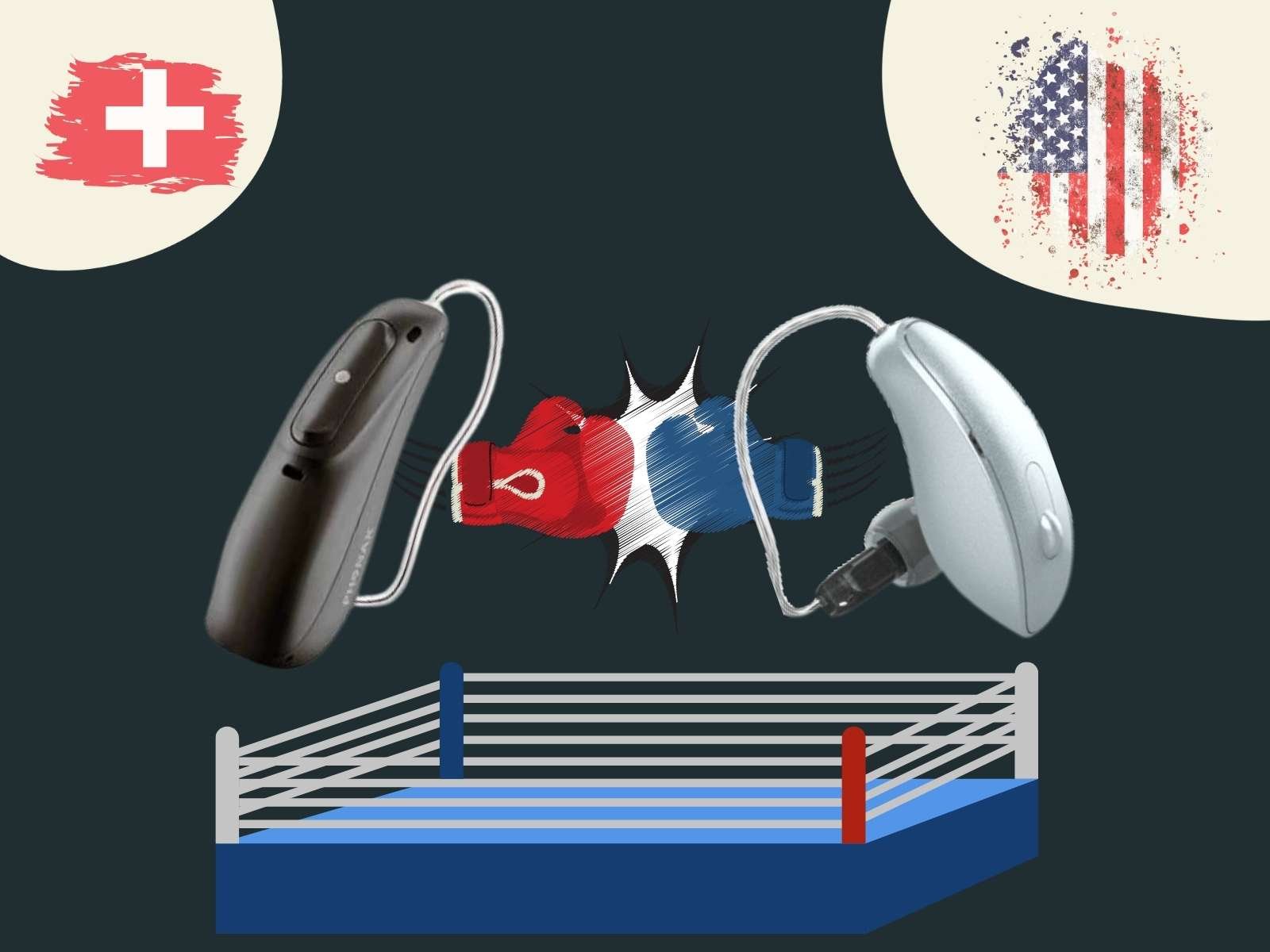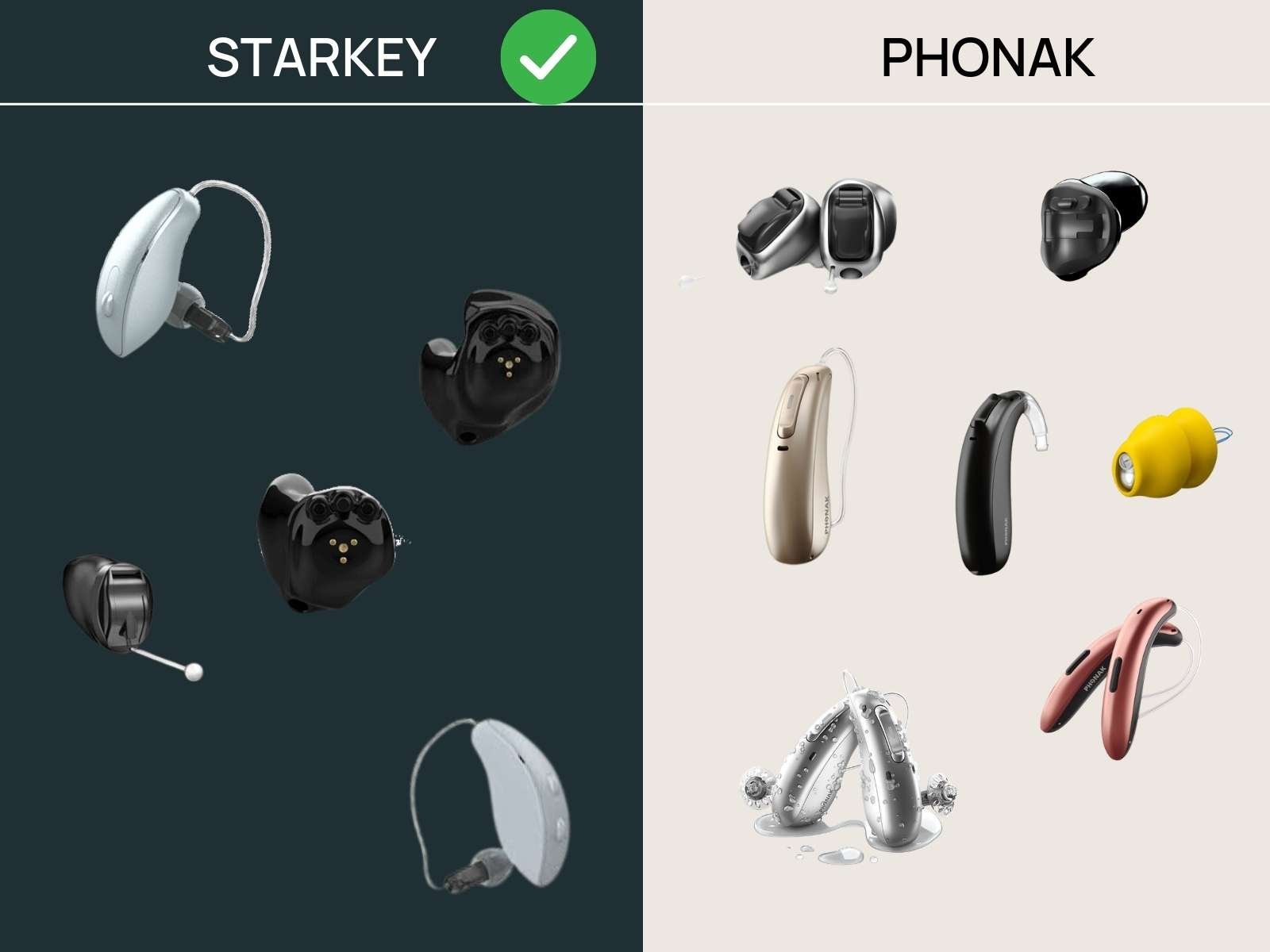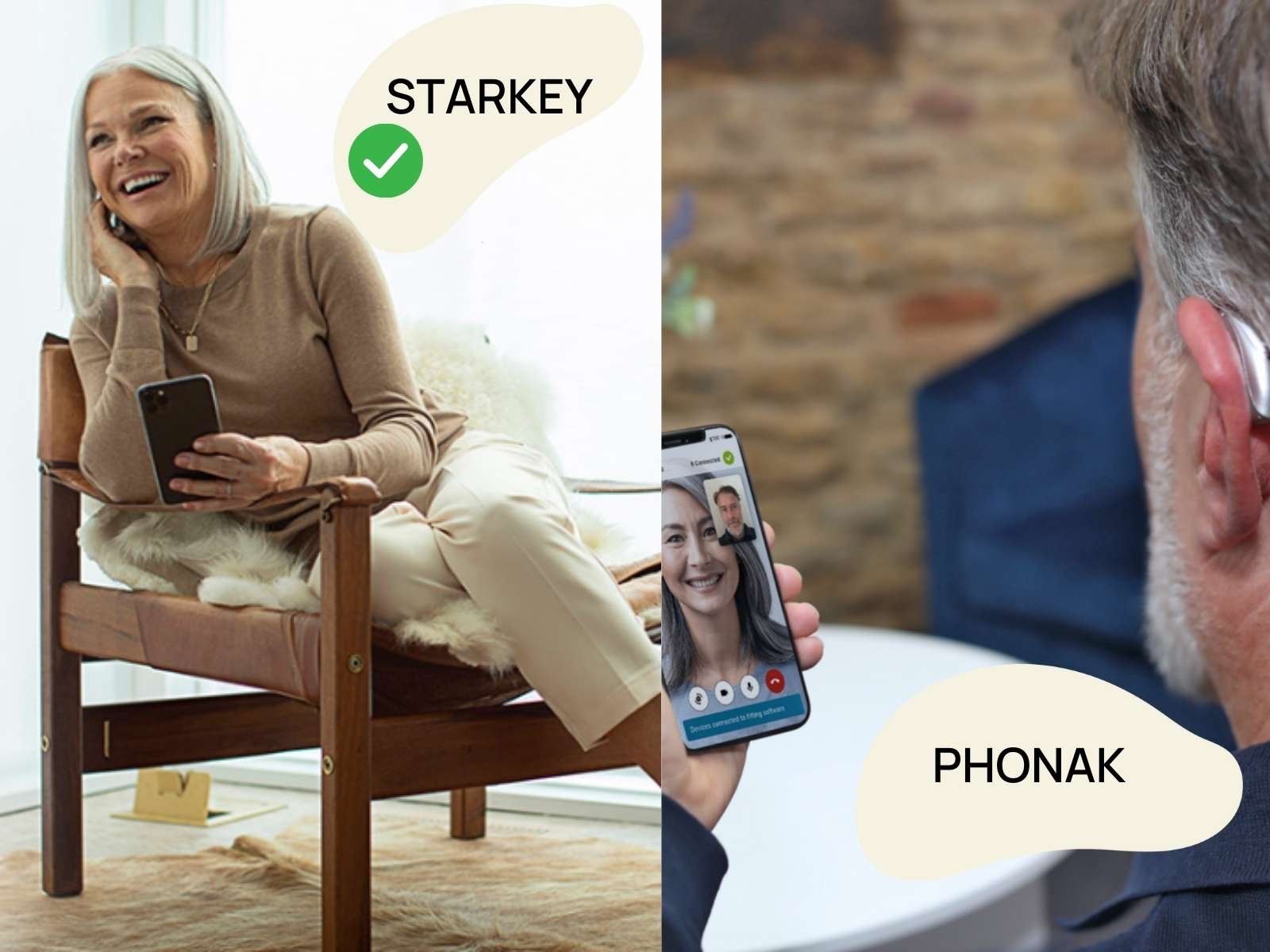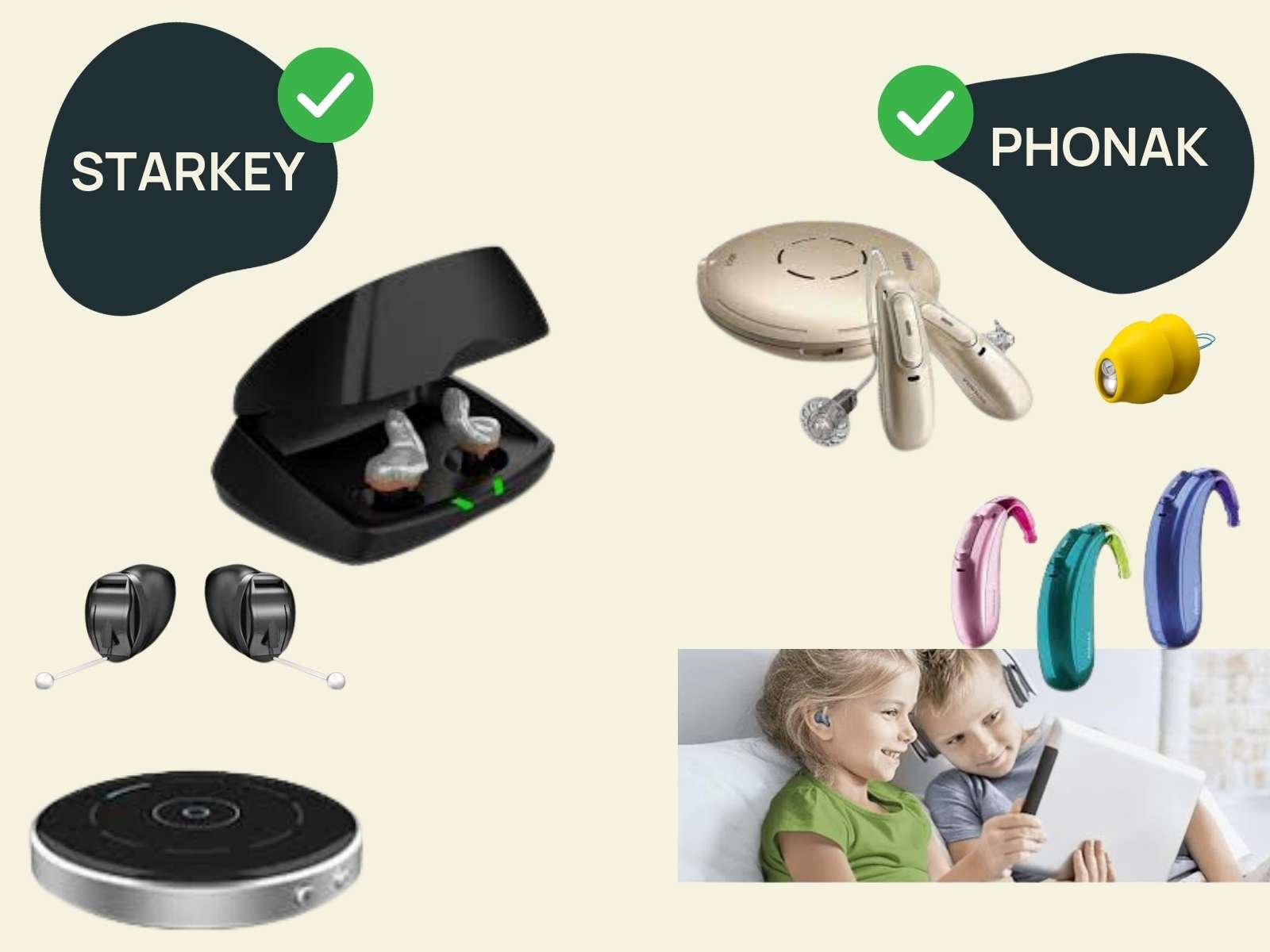As an audiologist, I’ve worked with all of the major brands. Recently I got to try the latest models from both Phonak and Starkey, and I’m excited to share some ear-resistible insights from these two side by side. To keep things interesting we’ll skip the typical pros and cons list and spice things up with a fun twist. Are you ready? Here we go!
Choosing the right hearing aid can be daunting, especially when you need help figuring out what to look for. With so many options in the market, it can be overwhelming to decide which brand and model will meet your specific needs. With hearing aid selection, my patients appreciate a nuanced breakdown. It’s not always as simple as a one-size-fits-all answer. That's why we're here to bring you an epic face-off between two top contenders in the hearing aid world: Phonak and Starkey. These hearing aid powerhouses are going head to head in a showdown that won't leave you ready to throw in the towel on your hearing aid search. Prepare for a clash of the Titans as we compare everything from sound quality to special features. Let's dive in!
The Contenders

We have the Swiss sensation Phonak in the left corner, weighing in with superior sound quality and dynamic features! This brand's prowess in the hearing aid arena is unquestionable, with a reputation for delivering crystal-clear sound, making it a formidable contender.
And in the right corner, hailing from the United States, is the tech-savvy titan, Starkey! Known for its innovative features and remarkable customization options, Starkey packs a punch when it comes to personalization.
Ladies and Gentlemen, brace yourselves as these two giants of the hearing aid world square off in a head-to-head battle. From style and design to Bluetooth connectivity and app controls, they're leaving no stone unturned in their quest for victory. May the best hearing aid win!
Round One - Styles

Phonak's rounded, teardrop-shaped receiver-in-canal (RIC) hearing aid is visually pleasing, though the overall look is mostly unchanged compared to the previous Paradise generation. One new addition to Phonak's line is the Slim. The slim RIC design is similar to Signia's Styletto hearing aid. This additional option is excellent for patients looking for a fun, modern look.
A toggle switch feature is also a perfect option for patients who prefer manual volume or program adjustments instead of the Smartphone app, allowing for multiple options, including up/down and short press or long press. However, the double-tap feature can have its quirks for answering calls or starting/stopping streaming. Patients sometimes have trouble triggering this feature (or, conversely, triggering it at an unwanted time). Fortunately, a 'demo mode' lets you practice the double tap in the clinic with feedback about whether it worked (note: only available in the clinic hearing aid software). The Phonak style and design overall receive good marks.
Starkey's new Genesis has an ultra-sleek, modern look that will appeal to those who want a more futuristic approach. This new facelift is a very different look from the previous Starkey Evolv and, in my opinion, a very positive change. The single push button will appeal to those who like to keep it simple, and your audiologist can program it to do various tasks (e.g., volume control, program change, streaming, etc.). However, in contrast to a toggle switch, it provides fewer manual options (e.g., limited to between two or three options). The telecoil option, however, is slightly larger and has two buttons.
A plus point for Starkey's tap control: your audiologist can customize how sensitive it is to tap control. For example, it can be set for light touch if you have trouble pressing hard enough. Or vice versa, if you are accidentally triggering it, it can be set to respond to a more robust double tap. As an audiologist, I appreciate that every patient is different, and the software lets me customize exactly what that patient needs or prefers. Starkey also wins extra points for its rechargeable custom hearing aid options, which more and more patients are requesting these days when it comes to custom devices.
It's nearly nose to nose here, but Starkey's new updates push it over the edge, winning this round.
Round Two - Bluetooth Connectivity

Starkey works with iPhone and Android phones (check here for compatible Android models). When I wore the Starkey Genesis, I found the Bluetooth connection with my iPhone to be quite good. It might be due to their improved Bluetooth connectivity with its new antenna placement in the Starkey Genesis. However, if you're looking to connect to multiple devices at once, Starkey doesn't have that capability currently. Hands-free calls are no problem with iPhones, but they won't work for Android.
Phonak, on the other hand, is very versatile when it comes to Bluetooth device connectivity. Whether you prefer Android or iPhone, Phonak's Bluetooth connection can connect to any device, be it a laptop, iPad, Android, or iPhone. Patients also appreciate the ability to connect to multiple devices at once. And if you're looking for hands-free calling options, Phonak will work for Android and iPhone.
Phonak wins this category due to its versatile Bluetooth connectivity options for multiple devices, including Android and iPhone.
Round Three - App Controls

Phonak's app allows users to control their devices with a remote control. In the MyPhonak app, users can control volume, change programs, and track their hearing health. There's also an option to create programs, allowing patients to adjust the sound to what they prefer. However, I'll note here that, unfortunately, these custom programs will disappear if you visit the hearing aid clinic and connect to the hearing aid software. One downside is for those who like to have peace of mind in case they lose their hearing aids, as the app doesn't have a feature for lost hearing aids.
Starkey's app has a lot of fantastic features. Edge Mode will be super helpful if you need some environmental adjustments, offering suggested changes based on your input. The self-check feature lets you troubleshoot on the spot. For example, if your device works fine according to the check, you may only need to change a wax guard. I've often seen patients come in thinking their device isn't working, but all it needed was a quick wax guard change. While this feature doesn't work 100% of the time, it could save you a trip to the clinic and also help any caregivers determine whether they need to coordinate a trip to the hearing aid clinic. This could be a worthwhile feature for some patients, especially those in care facilities. Caregivers will also appreciate the companion app that can provide valuable insight into how the devices work and detect falls.
Starkey's app wins with its hearing aid self-check feature, "Find My Hearing Aids" function, Companion app, Fall Alert, and Edge Mode.
The competition is heating up! Stay tuned to find out who will win the final two rounds.
Round Four - Special Features

Each has some great features, so it depends on what's important to you. Both have durability - Starkey, with its newly designed Hydrashield feature, and Phonak, with its Lumity Life, are great options for active or outdoor fans. Rechargeable RICs are available for both brands.
Starkey leads with their custom hearing aids, which have also implemented the latest Genesis technology on the inside. Starkey's CIC (completely-in-canal) with table mic combination is an excellent alternative for those seeking a discreet hearing aid while still improving in background noise. Additionally, their rechargeable ITE (in-the-ear) and ITC (in-the-canal) are popular choices in custom devices. If you're looking to go the custom hearing aid route, Starkey is definitely one of the best options out there. Along with its "Find My Hearing Aid" feature and companion app, it's also a fantastic option for caregivers or those needing extra peace of mind.
On the other hand, Phonak offers the broadest range of colors, pediatric options, and truly invisible hearing aids with Lyric. They also offer assistive technology with Roger devices, which can be handy for those interested in additional background noise support. While Roger technology is on the pricey side, patients love this technology. One small point to mention with Phonak RICs is their wax guards, which come in a small, round disc. For patients with poor dexterity, these can be tricky to maneuver. If you're looking for the best Bluetooth connectivity, sporty slim RIC, completely invisible hearing aids, fun colors, pediatric options, or extra background noise help with Roger, Phonak is an excellent choice.
It all comes down to what features are important to you. But the choice is ultimately yours to make. This one's a tie.
Round Five - Sound Quality

Phonak's hearing aids provide sharp, percussive sound quality with smooth adjustments. I like how Phonak's processing manages sudden, loud impulse sounds, and background noise management was good during my trial. Streaming sound quality is good, though music streaming has a hollow quality. I was able to tweak this a bit, but I prefer a bit more bass.
I'm really impressed with the sound quality of the new Starkey Genesis. Starkey's Genesis offers a fully developed, effortless sound with high fidelity thanks to its Neuro Processor with a deep neural network (DNN). My perception was a more natural hearing aid sound that felt less processed and more seamless. I especially enjoyed the way music streaming sounded.
The winner of this round is Starkey - their new processing sounds fantastic. However, sound quality can be subjective, so you may wish to take them out for a test yourself.
The Winner
While this was an incredibly close match, with both contenders exhibiting impressive features and noteworthy strengths, Starkey ultimately reigns supreme in the ring. Its innovative technology, coupled with a robust set of features and exceptional sound quality, make it the standout choice. However, it's essential to remember that the 'best' hearing aid is largely subjective and depends on each user's unique needs and preferences. Despite Starkey taking the trophy in this comparison, Phonak remains a formidable competitor, offering a diversified range of options, especially for those seeking superior Bluetooth connectivity and a colorful array of styles.
Conclusion:
Choosing between Phonak and Starkey hearing aids is ultimately a matter of personal preference that should be based on an individual's lifestyle, specific hearing needs, and the level of technology they're interested in investing in. It is reassuring to know that both companies offer products that can improve the quality of life for their users. You can determine which hearing aid best suits your needs by comparing each brand's features and capabilities. If you're unsure where to start or need more guidance, check out our other resources, such as the Soundly Scorecard, Live Listen, and in-depth reviews of each product.






